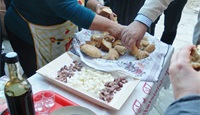
The Mediterranean diet involves a set of skills, knowledge, rituals, symbols and traditions concerning crops, harvesting, fishing, animal husbandry, conservation, processing, cooking, and particularly the sharing and consumption of food. Eating together is the foundation of the cultural identity and continuity of communities throughout the Mediterranean basin. It is a moment of social exchange and communication, an affirmation and renewal of family, group or community identity. The Mediterranean diet emphasizes values of hospitality, neighbourliness, intercultural dialogue and creativity, and a way of life guided by respect for diversity. It plays a vital role in cultural spaces, festivals and celebrations, bringing together people of all ages, conditions and social classes. It includes the craftsmanship and production of traditional receptacles for the transport, preservation and consumption of food, including ceramic plates and glasses. Women play an important role in transmitting knowledge of the Mediterranean diet: they safeguard its techniques, respect seasonal rhythms and festive events, and transmit the values of the element to new generations. Markets also play a key role as spaces for cultivating and transmitting the Mediterranean diet during the daily practice of exchange, agreement and mutual respect.
The element, inscribed in 2013 on the Representative List of Intangible Cultural Heritage of Humanity, was jointly proposed by Croatia, Cyprus, Greece, Italy, Morocco, Spain and Portugal. Each country selected an emblematic community, respectively Hvar and Brač, Agros, Koroni, Cilento, Chefchaouen, Soría and Algarve.
According to the Intergovernmental Committee, the multinational nomination of the Mediterranean diet was approved for inscription on the Representatiove List based on the following:
-
Transmitted from generation to generation, particularly through families, the Mediterranean diet provides a sense of belonging and sharing and constitutes for those who live in the Mediterranean basin a marker of identity and a space for sharing and dialogue;
-
Inscription of the element on the Representative List could contribute to raising awareness of the significance of healthy and sustainable food related practices in other parts of the world, while encouraging intercultural dialogue, testifying to creativity and promoting respect for cultural, environmental and biological diversity;
-
Safeguarding measures focus on raising awareness, transmission, documentation, revitalization as well as legislative actions; emphasis is placed on strengthening cooperation mechanisms between and among the communities and States concerned;
-
Through several meetings, the communities concerned in seven countries participated in the preparation of the nomination and gave their free, prior and informed consent;
-
The Mediterranean diet and its local manifestations have been the subject of research and documentation in each of the States Parties concerned and figure into one or more inventories in each State.
Agros, the emblematic community of Cyprus
Agros is a traditional village in the Troodos Mountains, in the Pitsillia area. It stands on a wine route, surrounded by vineyards, pine trees, wild roses and herbs, among others. The diverse natural surroundings, the rich cultural heritage, the warm hospitality of the inhabitants and the preservation of several traditions make the Pitsillia area in general –and Agros in particular- one of the most beautiful places in Cyprus and highly representative of the cultural identity of the island. Some of the traditional products made there are: tsamarella, hoiromeri, posyrti and lountza pitsilias, zivania, soutsioukkos, ppalouzes, kkiofterka, traditional sweets and the well-known Agros rose water.
Video:
More information: